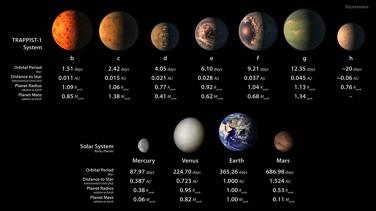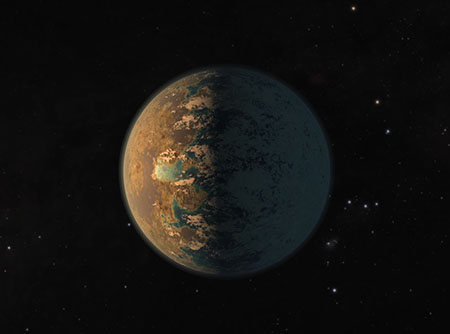Let’s review the seven planets’ physical characteristics. Many parameters have been calculated, including their sizes, masses, and densities, their average surface temperatures, and the amount of irradiation (sunlight) they receive. We are least certain about the TRAPPIST-1h values because fewer transits have been measured – only one transit, by Spitzer, compared with 37 transits for the innermost planet.
Their densities range from about 60% to 117% of Earth’s 5.51 grams per cubic cm, indicating that they are predominantly rocky. The densest ones, 1c and 1d, probably have a heavy iron core surrounded by a silicate rocky mantle. The least dense ones could contain up to 25% water in liquid form or as ice - or simply appear larger in diameter due to an opaque atmosphere, reducing the calculated density.
The planet with the largest radius and most mass, TRAPPIST-1g, is the outermost exoplanet in the habitable-zone, and the best candidate for liquid surface water or ice and an atmosphere. The smallest is 1d, which sits just inside the habitable zone, and likely has little or no surface water.
Based upon the brightness of the red dwarf star and the distance from the star, astronomers have calculated the amount of sunlight received on the surface of each planet compared to that received by Earth. Despite orbiting dramatically closer to their star, they receive amounts similar to our solar system. TRAPPIST-1b receives 4.25 times the amount of sunlight we get on Earth (a bit less than Mercury does), and TRAPPIST-1h receives one-eighth of what we receive (similar to what dwarf planet Ceres receives). The mean surface temperatures range from 400 K (127°C) for innermost TRAPPIST-1b to a chilly 168 K (-105°C) for distant TRAPPIST-1b. The planets in the habitable zone range between 251 K and 199 K (-22°C and -74°C), allowing their equatorial and temperate regions to have Earth-norm temperatures.

